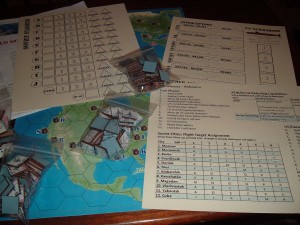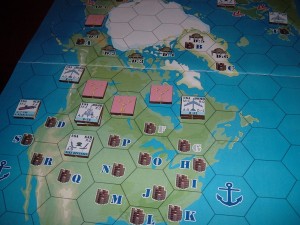Red Menace
Developer: R. Brent Ward
Pubhlisher: White Dog Games
Author: Scott R. Krol
Can nuclear war in the ‘50s translate into an exciting solo experience?
There was a time when kids looked to the skies in fear, expecting an incoming onslaught of Soviet missiles and bombers to wipe out the world in a blaze of nuclear fire at any moment. Today the biggest fear most kids have is not having enough Twitter followers. Times have definitely changed since the height of the Cold War, but now everyone can relive those glorious days of duck and cover with White Dog Games’ latest title, Red Menace. So put on a ‘I Like Ike!’ button, groove to Buddy Holly, and let’s fight the fight that never happened.
Red Menace is a solitaire board game set in the year 1959 of nuclear war between the Soviet Union and the United States, with collateral damage being spread to Canada, Greenland, Great Britain, and possibly Cuba. The player takes on the role of supreme commander of the joint forces of the USAF, RCAF, and RAF as they try to intercept waves of Soviet bombers, controlled partly by the game, before they drop their megadeath. At the same time the player sends out US and British bombers to turn Soviet cities into glowing piles of slag. Yep, family fun gaming at its most jolly!
What you get in the boxed version. Pretty cool components for a small company. Print and play and folio editions are also available.
There are three scenarios: a Soviet first strike, a US first strike, and a joint US/UK first strike. All three differ only by which side begins with bombers already inbound. It’s a bit odd that two out of the three postulate US first attacks; one would assume that the third scenario would be a mutual attack between the Soviets and the US.
Red Menace focuses strictly on bombers and interceptors, with the exception of a lone US sub and the possibility of Soviet sub attacks via random events. According to the designer’s notes the year 1959 was chosen specifically for this reason, as there was much more fear of waves of attacking Soviet bombers than ICBMs at the time. Besides, with no Star Wars systems in play how much fun would a game of watching missiles track be? At least bombers can be shot down, and thus give the player something to do in response to the incoming attacks.
Turns begin with a random event phase that can really change how a game plays out. Examples of some of the events include Cuba aiding the Soviets, nuclear AAM missiles, changes in one side’s war effort, and even nuclear attacks by Soviet subs. Once the random event is processed the rest of the turn is one of action and reaction. The Soviets launch a new flight of bombers, Soviet bombers are moved towards their target cities by the player, the defenders in the US, UK, and Canada respond, nukes are dropped, and then it’s flipped with the US and UK (the RCAF has interceptors, but no bombers) trying to penetrate Soviet airspace to deliver their payloads.
Since the game deals with a subject matter that has thankfully never happened it is difficult to compare and contrast the game system (and make no mistake, Red Menace leans towards game and not simulation—not that there’s anything wrong with that) with the history of the conflict. One would think though that in a real nuclear war there would be a lot of chaos and frayed nerves during the danse macabre. Imagine the immense pressure of being a fighter pilot who cannot fail or millions of his fellow citizens will die. Unfortunately Red Menace plays out in such a way that it feels more like a ballet than a mosh pit.
Unless the Soviets get a tail wind (an event that lasts only for one turn and has the potential of being chosen once a game) every bomber moves at the same rate. Targets for the Soviet flights are chosen when they are deployed by rolling on a random table based on where the bombers launch. What this means in terms of gameplay is that for the player defending North America and the British isles, it is very, very easy to game the system since the target, and how long it will take to get there, is always a known value. Sure, there’s a wing of Red bombers flying over Omaha right now but why bother intercepting because we know they’re actually headed for Phoenix and we have a couple more turns to deal with them.
Interception in Red Menace is a lot less stressful than one would imagine during the real deal, and judging from the comments on many forums regarding the game’s handling of the procedure, this reviewer is not the only gamer who feels that way. Essentially the player has a pool of interceptors each turn to defend with, the only restrictions being that the interceptors only defend their nationality’s cities and can only do so when the Soviets are actually in a city hex. For the player they can intercept with as many interceptors as available, while the system only gets to defend Soviet territory with one interceptor per attacking bomber flight.
Very early in the fight. Notice the impressive thickness of the counters. One could tile kitchen floor with them.
So the player is allowed to gang up on the Soviet bombers, who arrive in a staggered piecemeal fashion, while the player can overwhelm the Soviet defenses by intelligently controlling his attacking bombers. And since the player knows where the Soviet bombers are going there is no incentive to weaken his interceptions by not ganging up, since as mentioned previously the player knows there is no threat to cities that are being flown over. Compounding the problem is that interceptors are allowed to fly every turn, meaning there is never a reason not to go after the bombers.
If in 1959 SAC was able to precisely know where every Soviet bomber was headed, when it would arrive, its exact flight path, and had the ability to keep on sending interceptors after them without worry of pilot fatigue, weapon supply, or aircraft maintenance, we would have filled the skies with B-47s and B-52s headed over the polar cap. Barring some really bad die rolls and random events, Red Menace in its basic out-of-the-box form is typically not much of a challenge, especially for the types of players that really enjoy “gaming” systems.
White Dog Games has partially rectified this by releasing a set of variant rules that probably should have been present from the beginning. Interceptors can now engage at long range, but at the cost of losing them for a turn. Soviet air defenses, which in the standard game are positioned before the first turn and remain in those hexes, are now repositioned every time a US or British flight enters air defense hexes. And the biggest change: bombers are positioned in cities before the game. In the standard game there is never a loss to the US and British bomber groups unless shot down over Soviet areas. Now it is possible to watch your attack force be whittled down due to the loss of cities.
Even with the variant rules the game can feel a little too predictable. Thanks to its overall simplicity though it is easy enough to add house rules. Already folks are experimenting with different ways to handle the interceptors, and this reviewer has toyed around with everything from different ways to assign targets, to variations on the incoming waves, to more deadly attacks.
Great solitaire gaming depends on a few factors. One, the subject matter should be one that can handle solo play. Two, the player should be faced with many decisions that impact (or at least feels like they impact) the game. And three, if there aren’t many decisions at least provide an excellent narrative structure to make the game unfold like a story.
Red Menace is strong with factor one, somewhat weak with the second factor, but can provide an interesting narrative at times. One of the best games I played was when everything seemed to be going wrong. Soviet sub attacks took out major cities in the very first two turns of the game, obliterating a number of bombers on the ground. Once the bombing began in earnest the Soviets were red-hot with their die rolls, the US, quite the opposite. Yet, at the very end the US squeaked out a victory by just a few points. Now that was a game to remember. Chaos rules, order drools.
Interceptors ready to launch. Note that after being used even though they are moved to the Refuel/Rearm box they can scramble the very next turn.
Ultimately Red Menace is an interesting game on a different kind of wargaming topic, but unfortunately not one that will go down as a classic solo experience like Carrier, B-17 Queen of the Skies, or Barbarian Prince. It is by no means a bad game, just one that sounds a lot more enjoyable than its reality. Still, there is a lot of potential to expand it with more variant rules, and even at its most basic there is something sickly rewarding about playing a game that results in mushroom clouds covering the board.
Grumpy Grog Sez: Better dead than Red! Controlling hordes of B-52s while protecting the homeland from atomic attack can be enjoyable, even if it’s a little too easy to be “gamey” with the system.
Recommendations






Leave a Reply